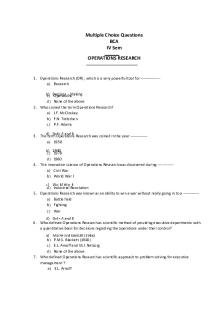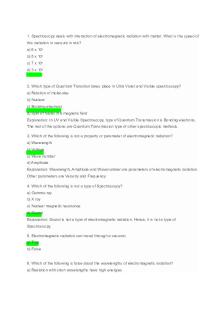Ch. no. 1 MCQ (EME) - mcq PDF

| Title | Ch. no. 1 MCQ (EME) - mcq |
|---|---|
| Author | amit katu |
| Course | Metrology |
| Institution | Shivaji University |
| Pages | 4 |
| File Size | 94.4 KB |
| File Type | |
| Total Downloads | 29 |
| Total Views | 157 |
Summary
mcq...
Description
Chapter No.1 Introduction to Metrology
Q.1 Metrology is defined as science of ________ A. Measurement B. Instrument C. Inspection D. Calibration Q.2 Which is not the type of metrology? A. Legal metrology B. Scientific metrology C. Industrial metrology D. Commercial metrology Q.3 Precision is defined as the ________________ of measuring process. A. Readability B. Repeatability C. Reproducibility D. Traceability Q.4 Sensitivity is the ability of measuring instrument to detect ______________ variation in a quantity being measured. A. Big B. High C. Small D. Less Q.5 Which is the source of error? A. Defect in instrument B. Environmental effect C. Adjustment of an instrument D. All Q.6 Least count is the smallest ____________ that can be measured by using a particular instrument A. Measurement B. Value C. Range D. Dimension. Q.7 The study of scientific metrology deals with a. accuracy and methods of measurement b. standard specifications c. theories related to nature d. all of the above Q.8 Which of the following causes is/are responsible for systematic errors? a. non linearity b. change in sensitivity c. zero offset d. All of the above
Q.9 Which of the following errors are also known as cumulative errors? a. Random errors b. Systematic errors c. Gross errors d. System interaction errors Q. 10 The degree of closeness of the measured value of a certain quantity with its true value is known as a. b. c. d.
Accuracy Precision Standard Sensitivity
a. b. c. d.
Q.11 Error of measurement = True value – Measured value Precision – True value Measured value – Precision None of the above
a. b. c. d.
Q.12 The ability by which a measuring device can detect small differences in the quantity being measured by it, is called its Damping Sensitivity Accuracy None of the above
a. b. c. d.
Q.13 To compare an unknown with a standard through a calibrated system is called Direct comparison Indirect comparison both ‘a’ and ‘b’ None of the above
14. Which of the following is caused by careless handling? a) Systematic error b) Gross error c) Random error d) None of the mentioned
Answer: b Explanation: Gross errors are mostly due to lack of knowledge, judgment and care on the part of the experiment. That is Gross error is caused by careless handling. 15. ‘A system will be error free if we remove all systematic error’. a) True b) False Answer: b Explanation: Random errors will remain in a system even if we remove all systematic errors. Random errors are also known as residual errors. 16. Which of the following error is caused by poor calibration of the instrument? a) Random error b) Gross error c) Systematic error d) Precision error Answer: c Explanation: Systematic errors are caused by poor calibration of instruments. 17. How systematic errors are eliminated? a) Frequent measurement b) Replacement of instrument c) Finding mean of reading d) Finding variance of reading Answer: b Explanation: The possible way of eliminating systematic error is the replacement of instruments. Systematic errors are caused by poor instrument calibration. 18. ‘Zero error is an indication of instrumental error’. a) True b) False Answer: a Explanation: Zero error refers to a false indication of an instrument when the true value is zero and zero error can be treated as an instrumental error. 19. Which of the following gives an idea_ about the ability of the equipment to detect small variation in the input signal (quantity being measured) A .Readability
B. Accuracy C. Sensivity D. Precision 20. If attempts are made to make an instrument very sensitive, which of the following qualities is likely to be impaired A. Precision B. Accuracy C. Readability D. Range ability 21 The purpose of the instrument is to A. Allow measurements to be made. B. Transmit the information C. Change signals D. Any of the above...
Similar Free PDFs

Ch. no. 1 MCQ (EME) - mcq
- 4 Pages

MCQ 1 - MCQ 1
- 4 Pages

Mcq - mcq
- 9 Pages

Chapter 1 MCQ - Practice MCQ
- 22 Pages

MCQ - MCQ
- 16 Pages

MCQ 1
- 13 Pages

MCQ - agile mcq
- 7 Pages

MCQ - MCQ | simulation
- 12 Pages

IPC MCQ Chapterwise - Mcq
- 184 Pages

MCQ-SHRM- - MCQ
- 15 Pages

CS8392 MCQ - MCQ
- 29 Pages

Obgyn MCQ - MCQ
- 17 Pages

MCQ
- 30 Pages

DS MCQ - ds mcq
- 22 Pages

MCQ-BRFW - MCQ-BRFW
- 37 Pages
Popular Institutions
- Tinajero National High School - Annex
- Politeknik Caltex Riau
- Yokohama City University
- SGT University
- University of Al-Qadisiyah
- Divine Word College of Vigan
- Techniek College Rotterdam
- Universidade de Santiago
- Universiti Teknologi MARA Cawangan Johor Kampus Pasir Gudang
- Poltekkes Kemenkes Yogyakarta
- Baguio City National High School
- Colegio san marcos
- preparatoria uno
- Centro de Bachillerato Tecnológico Industrial y de Servicios No. 107
- Dalian Maritime University
- Quang Trung Secondary School
- Colegio Tecnológico en Informática
- Corporación Regional de Educación Superior
- Grupo CEDVA
- Dar Al Uloom University
- Centro de Estudios Preuniversitarios de la Universidad Nacional de Ingeniería
- 上智大学
- Aakash International School, Nuna Majara
- San Felipe Neri Catholic School
- Kang Chiao International School - New Taipei City
- Misamis Occidental National High School
- Institución Educativa Escuela Normal Juan Ladrilleros
- Kolehiyo ng Pantukan
- Batanes State College
- Instituto Continental
- Sekolah Menengah Kejuruan Kesehatan Kaltara (Tarakan)
- Colegio de La Inmaculada Concepcion - Cebu
